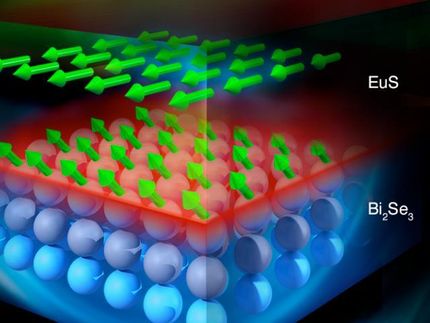Spin current on topological insulator detected electrically at room temperature
Researchers at Chalmers University of Technology have for the first time reported the electrical detection of spin current on topological insulator surfaces at room temperature by employing a ferromagnetic detector.

Schematics of the spin current on a topological insulator surface, with the spin direction (S) perpendicular to the current direction (kx). The zoom in schematic shows the electronic band structure on the surface of the topological insulator. The spin polarization on topological insulator surface is electrically probed by a ferromagnetic tunnel contact (FM).
Chalmers University of Technology
Solid-state materials were conventionally divided into three different classes such as conductors, semiconductors and insulators. Recently, a new class of materials has been proposed and realized, called “topological insulators”, where both the insulating and conducting properties can co-exist in the same material.
Topological insulators are insulators inside the bulk, but are conducting on their surfaces with less resistance than the conventional materials. This is possible due to their uniquely strong interaction between electrons’ spin and orbital angular momentum with their time reversal symmetry. The interaction is so strong that the spin angular momentum of the electrons is locked perpendicular to their momentum, and generates a spontaneous spin polarized current on the surfaces of topological insulators by applying an electric field.
These spin polarized conducting electrons on the surface have no mass and are extremely robust against most perturbations from defects or impurities, and can enable the propagation of dissipationless spin currents.
The researchers from Chalmers detected the surface spin current electrically on a topological insulator called bismuth selenide (Bi2Se3) for the first time at room temperature employing ferromagnetic tunnel contacts. Such contacts are known to be very sensitive to spin polarization and probe the Bi2Se3 surface by measuring the magnetoresistance due to parallel and anti-parallel alignment of the spin current and the ferromagnet magnetization direction.
“The key factors for these room temperature results are good quality topological insulator crystals and spin sensitive ferromagnetic tunnel contacts carefully prepared by clean room nanofabrication”, explains Dr. André Dankert, the lead author of the paper.
Earlier reports in this research field were limited only to measurements at cryogenic temperatures. From the results on the magnitude of the spin signal, its sign, and control experiments, using different measurement configurations, angles and interface conditions, the author’s rule out other known physical effects.
“Our results show the electrical accessibility of spin currents on topological insulator surfaces up to room temperature and pave the way for further developments, which can be useful for spin based information processing in the future”, says associate professor Saroj Dash, who leads the research group.
However, Saroj Dash cautions that the research on development of these new class materials and measurement techniques are still in its early stage and more experiments are required for further understanding.
Original publication
Other news from the department science

Get the chemical industry in your inbox
From now on, don't miss a thing: Our newsletter for the chemical industry, analytics, lab technology and process engineering brings you up to date every Tuesday and Thursday. The latest industry news, product highlights and innovations - compact and easy to understand in your inbox. Researched by us so you don't have to.



























































